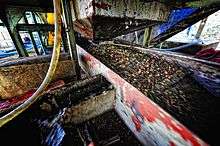Coffee production in Thailand

Thailand (formerly Siam) is one of the top coffee producers in the world as of 2014.[1] The country is ranked third among the coffee producing countries of Asia with the Robusta coffee accounting for 99% of its production.[2]
History
In 1891, the Board of Trade's Journal noted "that at the time, coffee cultivation, in a suitable locality and under favourable conditions, offered more remunerative prospects than any other agricultural enterprise, but that Java did not export more than one-third of the amount which that island used to produce." [3]
Production
Robusta coffee (Coffea canephora) is the chief coffee crop grown in the country which provides substantial economic return. Coffee arabica is grown in northern Thailand. The six provinces in southern Thailand where this coffee is grown are the Chumphon, Surat Thani, Nakhon Si Thammarat, Krabi, Pangnga and Ranong with reported coverage of an area of 67831.52 ha.[2]
Coffee production in the southern part of the country is 80,000 tons of Robusta coffee, and the northern region produces only Coffee arabica of about 500 tons. 20,000 tons of robusta coffee is for domestic consumption, in the form of dissolvable, roasted, powdered and tinned coffee.[2] Organic coffee is considered suitable for cultivation in the highlands with an elevation range of 800 metres (2,600 ft) to 1,200 metres (3,900 ft). Coffee is grown both in shaded areas and in open areas in full sun. Intercropping is also practised in hill areas along with fruit trees.[2]
The coffee production in the northern border region with Burma and Laos (The golden triangle) was initiated by the royal family of Thailand to replace opium for other crops. Under the Thai/United Nations Crop Replacement and Community Development Project coffee cultivation has been experimented with as a replacement crop for opium.[2] Arabica coffee has been recommended as a good variety as its yield is profitable to all categories of farmers, including the hill tribes.[2]
According to FAO statistics for 2013, coffee production was 50,000 tons from an area of 51,000 ha. The yield rate was 9,804 hectogram per ha, which placed it at the 18th position in the world ranking.[4] Thailand is nowadays able to produce high quality coffee grades. In 2015 two types of coffee (Doi Tung and Doi Chaang) received a geographically protected trademark of the EU. This is comparable to Champagne, Parma ham or wine from Bordeaux.[5]
References
 This article incorporates text from a work in the public domain: Board of Trade's Journal (1891)
This article incorporates text from a work in the public domain: Board of Trade's Journal (1891)
- ↑ Total Production of Exporting Countries, International Coffee Organization
- 1 2 3 4 5 6 Angkasith, Pongsak. "Coffee Production Status and Potential of Organic Arabica Coffee in Thailand" (pdf). Assumption University : AU Journal of Technology. Retrieved 7 June 2015.
- ↑ Board of Trade 1891, p. 440.
- ↑ "Thailand: Coffee, green, yield (hectogram per hectare)". Factfish.com. Retrieved 7 June 2015.
- ↑ 2 Thai coffee brands win EU geographic trademarks
Bibliography
- Board of Trade (1891). Board of Trade Journal (Public domain ed.). H.M. Stationery Office.
External links
 Media related to Manufacture of coffee in Thailand at Wikimedia Commons
Media related to Manufacture of coffee in Thailand at Wikimedia Commons